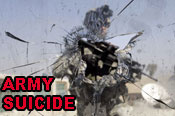 Suicide Rate in Army at a 26-Year High
Suicide Rate in Army at a 26-Year High
by Pauline Jelinek
WASHINGTON – Ninety-nine U.S. soldiers killed themselves last year, the highest rate of suicide in the Army in 26 years of record-keeping.
Nearly a third of the soldiers who committed suicide did so while serving in Iraq or Afghanistan, according to a report released Thursday. Iraq accounted for most of those – with 27 of the suicides coming from that conflict and three from Afghanistan. Also, there were 948 attempted suicides, officials said, adding that they didn't have a comparison for previous years.
The report said the 99 confirmed suicides among active duty soldiers compares with 87 in 2005 and is the highest number since 102 were reported in 1991, the year of the Persian Gulf War, when there were more soldiers on active duty.
Investigations are still pending on two other deaths.
In a half million-person Army, last year's suicide toll translates to a rate of 17.3 per 100,000, the highest since the Army started counting in 1980, officials said. The rate has fluctuated over those years, with the low being 9.1 per 100,000 in 2001…
Failed personal relationships, legal and financial problems and the stress of their jobs were factors motivating the soldiers to commit suicide, according to the report. It also found a significant relationship between suicide attempts and the number of days deployed in Iraq, Afghanistan or nearby countries where troops were participating in the war effort.
There was "limited evidence" to back the suspicion that repeated deployments are putting more people at risk for suicide, the report said. With the Army stretched thin by years of fighting the two wars, the Pentagon has had to extend normal tours of duty this year to 15 months from 12 and has sent some troops back to the wars several times.
Officials found no direct link between suicide and deployments or exposure to combat except in how they affect a soldier's marriage or other close relationships, Col. Elspeth Ritchie, psychiatry consultant to the Army surgeon general, said in a Pentagon press conference.
"Unfortunately, suicide is very often a compulsive act," she said, and the fact that soldiers are armed can make it harder to prevent.
"Very often a young soldier gets a 'Dear John' or 'Dear Jane' e-mail and then takes his weapon and shoots himself," she said.
Preliminary numbers for the first half of 2007 indicate the number of suicides could decline across the service but increase among troops serving in the wars, officials said.
The increases for 2006 came as Army officials worked to set up a number of new programs and strengthen old ones for providing mental health care to a force strained by the longer-than-expected conflict in Iraq and the global counterterrorism war entering its sixth year.
In a flurry of studies in recent months, officials found a system that might have been adequate for a peacetime military has been overwhelmed by troops coming home from war.
Some troop surveys in Iraq have shown that 20 percent of Army soldiers have signs and symptoms of post-traumatic stress, which can cause flashbacks of traumatic combat experiences and other severe reactions. About 35 percent of soldiers are seeking some kind of mental health treatment a year after returning home under a program that screens returning troops for physical and mental health problems, officials have said.
The Army has sent medical teams annually to the battlefront in Iraq to survey troops, health care providers and chaplains about health, morale and other issues. It has revised training programs, bolstered suicide prevention, is adding some 25 percent more psychiatrists and other mental health professionals to its staff, and is in the midst of an extensive program to teach all soldiers how to recognize mental health problems in themselves and their comrades.
The Army also has been working to stem the stigma associated with getting therapy for mental problems, after officials found that troops are avoiding counseling out of fear it could harm their careers.
"Go to Original" links are provided as a convenience to our readers and allow for verification of authenticity. However, as originating pages are often updated by their originating host sites, the versions posted on VT may not match the versions our readers view when clicking the "Go to Original" links.
(In accordance with Title 17 U.S.C. Section 107, this material is distributed without profit to those who have expressed a prior interest in receiving the included information for research and educational purposes. VT has no affiliation whatsoever with the originator of this article nor is VT endorsed or sponsored by the originator.)
ATTENTION READERS
We See The World From All Sides and Want YOU To Be Fully InformedIn fact, intentional disinformation is a disgraceful scourge in media today. So to assuage any possible errant incorrect information posted herein, we strongly encourage you to seek corroboration from other non-VT sources before forming an educated opinion.
About VT - Policies & Disclosures - Comment Policy




